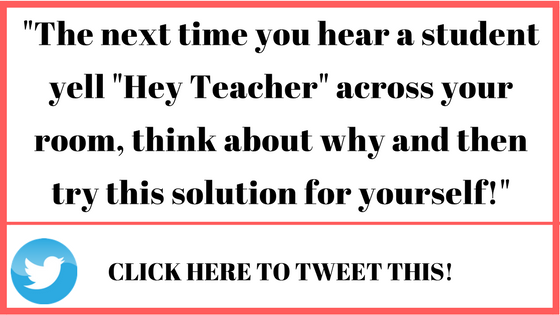“Hey Teacher!”
You’ve probably been there before. A student, frustrated with their hand in the air decides it’s all of a sudden ok to yell across the room “Hey Teacher!” (they might use your name, but you get the point). There’s a good chance this isn’t a rare occurrence in your classroom. You’re awesome, so you probably manage your classroom well and when this happens, you reinforce your expectations and model appropriate behavior.
And that’s good. That’s what you should do. But I’d like to take this a step further and look at what causes this type of disturbance to happen in your classroom.
The Classroom Management ‘Play By Play’:
Step 1: Bobby raises his hand across the room, silently, as they are supposed to. They can’t continue working without assistance. And because you are helping Katie at the moment, and your back is to Bobby, you don’t see him raise his hand.
Step 2: You finishing assisting Katie and move on to Jake, who is close by and just raised his hand. Now, you don’t know this, but Jake actually has a much less urgent question than Bobby, but because Jake was closer, you noticed him first. This frustrates Bobby, because he raised his hand first. He now feels like he is being ignored.
Step 3: Something comes up and you get a little side-tracked (maybe grabbing a paper, answer key, or another resource for Jake). All the while, Bobby (who raised his hand first) continues to get more frustrated and begins to fidget as his shoulder is starting to ache from holding his hand up.
Step 4: By this point, Bobby is feeling overlooked and angry due to the chain of events, so he yells “Hey Teacher!” Since you’ve been doing your job and taking care of your students, you have no idea why Bobby is so angry and acting out, so this can possibly lead to repercussions or consequences for him. This outburst may also hurt the flow of your class or distract other students as well as any discussion or disagreement that occurs afterwards.
Step 5: Bobby loses trust and confidence in his teacher and the support your are willing to provide him. And thus, Bobby starts to become one of “those” students…the ones who act out, cause trouble, and become unreachable.
It’s Not Your Fault.
This scenario can have a pretty negative ending, but it’s not your fault. Really it isn’t. At least not directly. Your were doing what you’re supposed to do, trying your best to meet the needs of your classroom. Sadly, even though there was no intended ill will or purposeful harm done, by not reaching that student in time, your relationship with them could be hurt. I’ll repeat: this is not your fault. This is the fault of the system that is typically being used to identify need in classrooms. The archaic use of a raised hand is out-dated and can lead to many situations just like the one described above. There is no indication of the severity of need, and let’s face it, it gets tiring raising your hand for a long time, so it’s frustrating for the student.
How About A Solution?
In order to prevent this from occurring in your classroom, easily implement what we call a “Triage System.” Triage is a medical term used in emergencies where doctors or nurses identify which patients to care for first, based on the severity of their injuries.
While that comparison may seem grim, the same concept can be utilized in your classroom. If you create a signaling system for students to use, that identifies the degree of their need, you can put your attention where it is needed most, first. This helps your students feel valued and prevents situations like the one described above. This also allows for a quick analysis of need, and your classroom’s progress on a given task or lesson.
We Use Cups. Why Not?
One of the easiest ways to implement a Triage System in your classroom is using cheap paper or plastic cups that are red, yellow, and green. The Green cup means that no help is required. The Yellow cup means the student has a question, but can continue working. And the Red cup means the student cannot continue working without your assistance. This creates a visual cue for you and allows the learner to complete an action without holding their hand up or, more importantly, stopping their work.
- Easy to set up. Easy to use.
- Simple “Cups” Triage System in Action
You can also use things like colored cards, clips, or any other form of visual representation. The important thing is that you can identify need immediately and provide needed help where it is required most. This will help you reduce management or “outburst” issues in your classroom.
This system is recommended, and used by most (if not, all) of the teachers we work with, but it has also been used very effectively in non mastery based as well.
So regardless of the current system you use in your classroom, the next time you hear a student yell “Hey Teacher” across your room, think about why and then try this solution for yourself!





